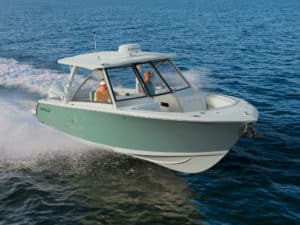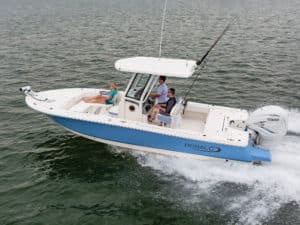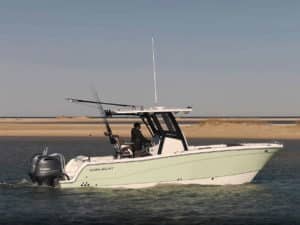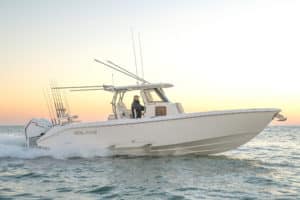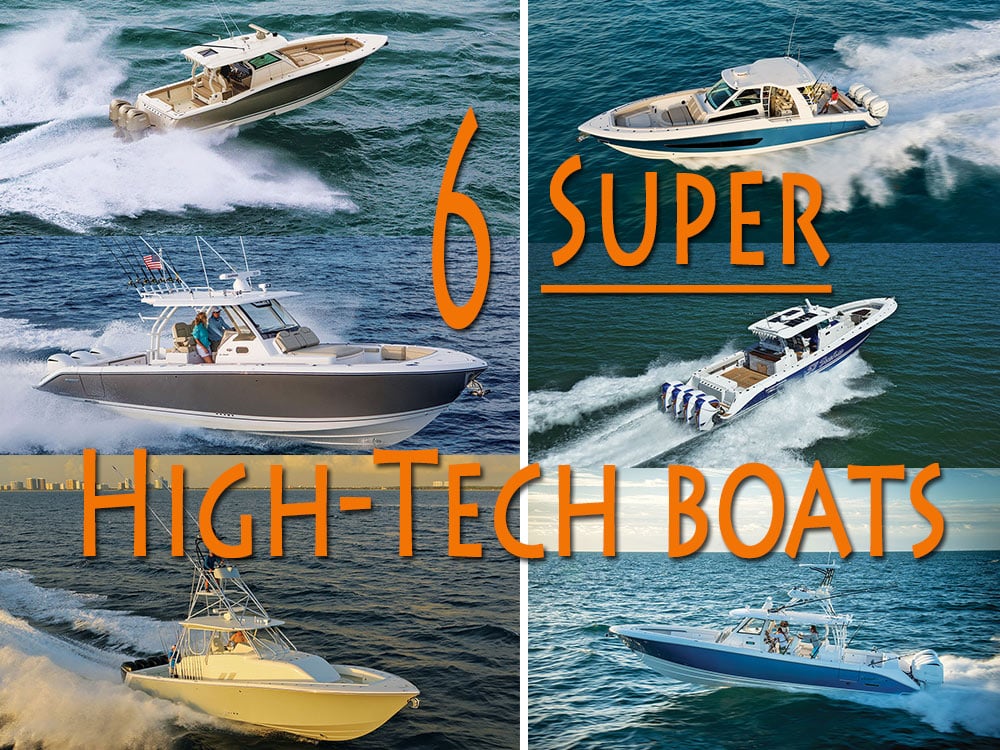
Technology: Love it. Fear it. Despise it. Regardless of your attitude toward all things innovative and occasionally extreme, we have to agree about one characteristic of today’s explosive technological progress: You’d better expect it.
High-end semicustom fishing boats, like luxury automobiles, surprise us each year with their fresh capabilities. To get a feel for the features — some standard, others optional — now trickling into the fish-boat market, we talked with six builders who are known for their leading-edge advancements. (Boats are listed alphabetically by builder.)
Boston Whaler 420 Outrage
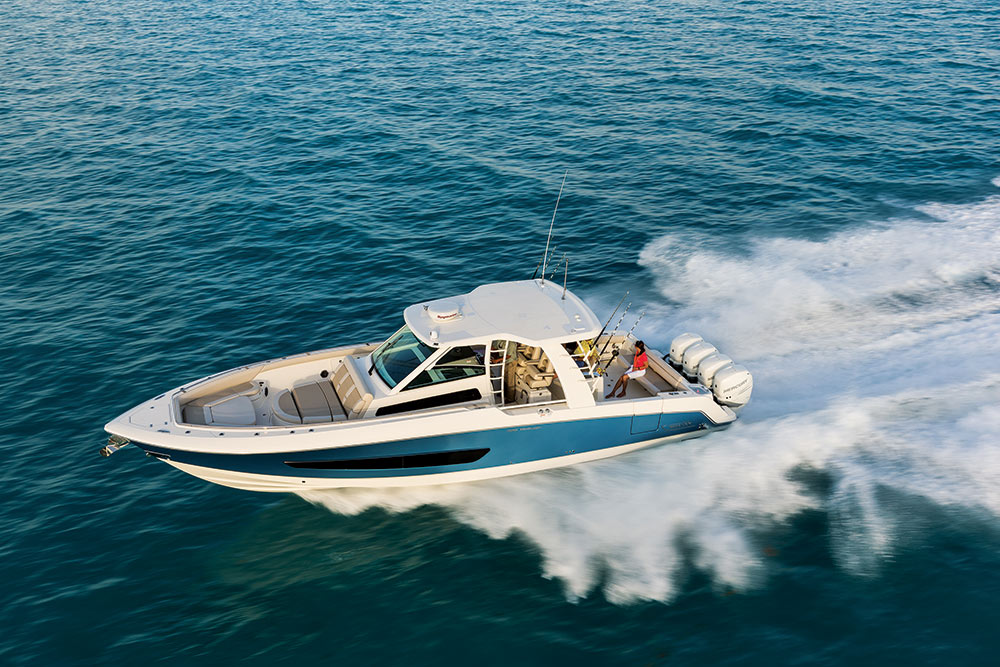
SPECS
Whaler’s Outrage flagship 420 represents a clean-sheet-of-paper design and incorporates the Lenco Auto Glide dynamic trim-tab system, says Wil Rogers, director of large boat business. The system automatically helps the hole shot, creates extra lift during acceleration and optimizes trim on plane.
The vessel also offers a fully integrated electrical platform: The Mercury outboards, Raymarine electronics and other electrical systems share a common network. The company’s Whaler Watch comes standard and allows for full remote monitoring of the boat with regard to both boat position (theft monitoring) and key functions.
Electronics and Control
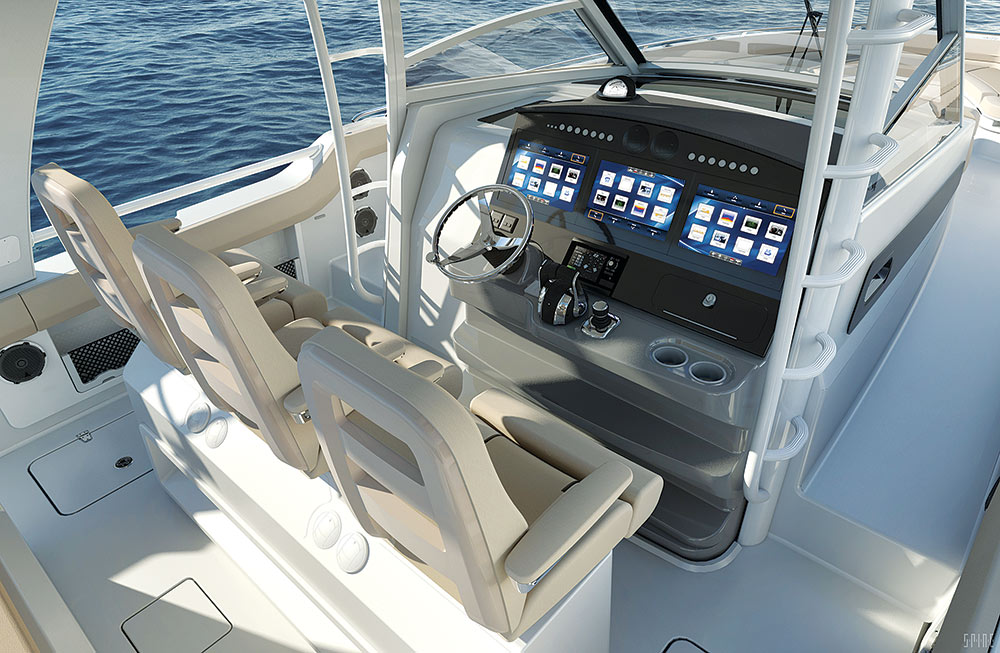
“The demand for integrated vessel management will only grow in the future,” Rogers says. “Our owners value the time they spend on the water, and eliminating the worry of systems issues will contribute to their enjoyment.”
Other standout features include a motorized vent at the top of the front windshield panel to usher in fresh air on hot days; a tablet device with an app to customize CZone digital switching; a motorized shade extending aft; hot and cold freshwater faucets, plus a retractable hose with hot and cold water for washing down the deck; a switch-activated teak bow table; and a freshwater washdown hose inside the anchor locker.
Tech Conveniences
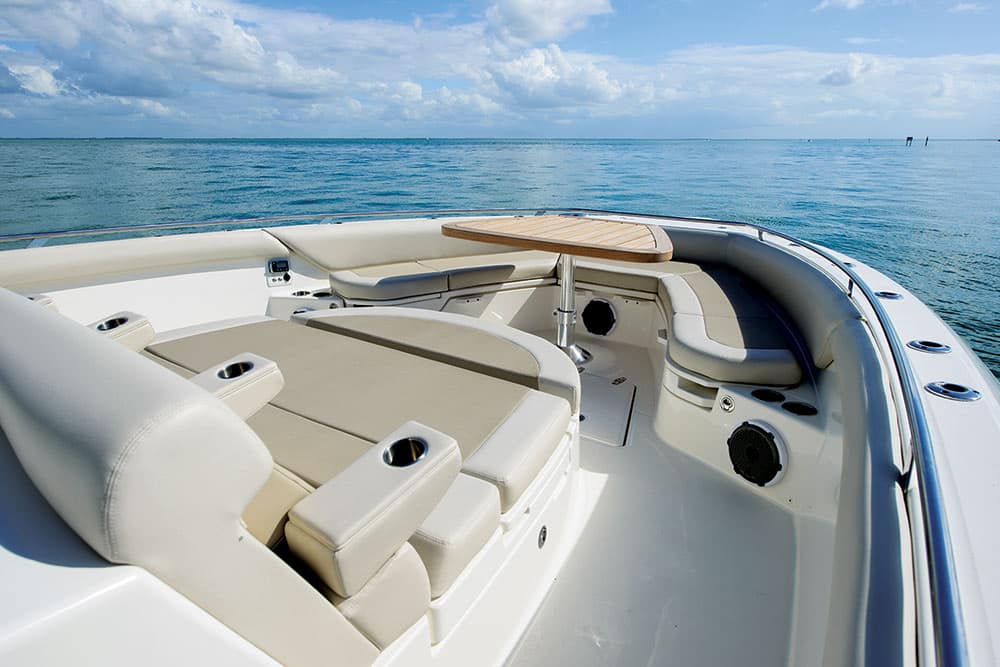
“The boat also has multiple air conditioners at the helm deck and in the cabin. Numerous refrigeration options, from fish boxes to cockpit refrigerator-freezers, should satisfy the most serious fishermen or pleasure cruisers,” Rogers says.
Everglades 435CC
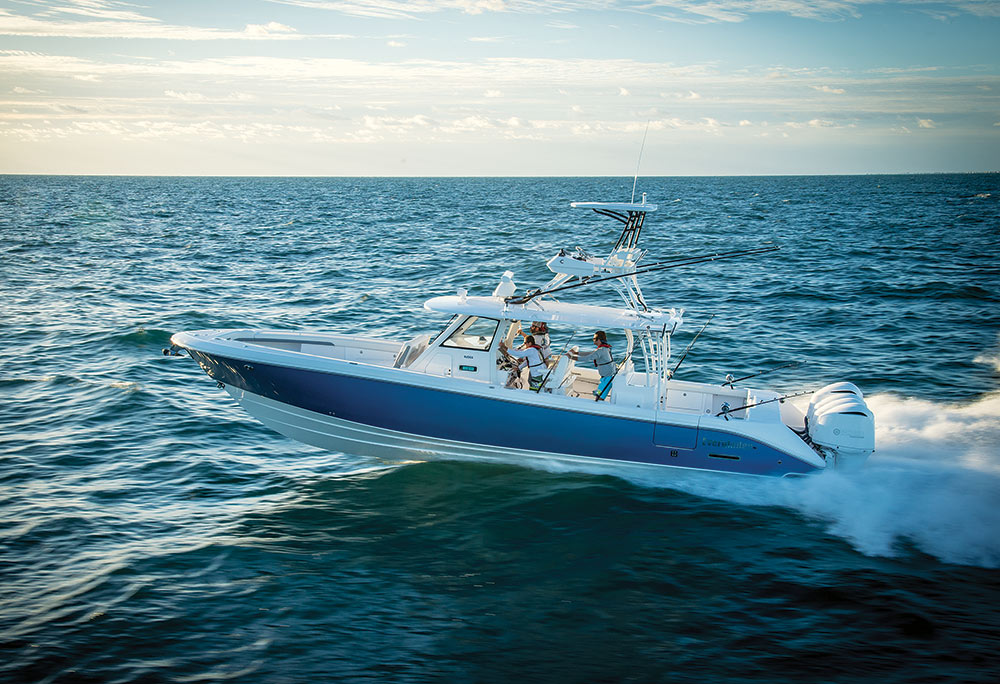
SPECS
Everglades was among the first boatbuilders to introduce cutting-edge features such as a patented hydraulic windshield. “There is no such thing as a perfect boat, and as long as technology can help us improve our product, we will continue to use it,” says Shane Kwaterski, director of dealer development.
In its construction, Everglades uses what it calls RAMCAP, building its hulls around pre-molded closed-cell structural foam. The center console and hardtop are constructed as a single unit, with the footing for the frame anchored to stringers belowdecks.
Boat Customizing
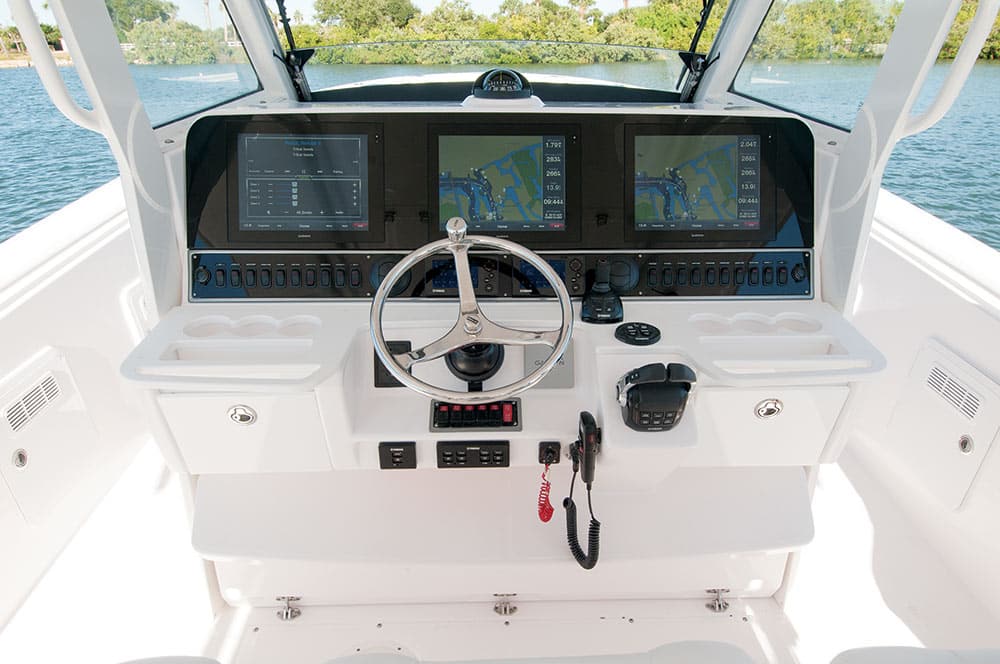
The company also looms all its wiring in-house, using tinned wire, Deutsch connectors, shrink tubing and circuit protection. The process allows buyers to customize onboard systems.
Everglades designed the 435’s helm to accommodate three flush-mount 16-inch displays to match yacht-style wheelhouses. The boat’s windshield raises and lowers electronically to allow airflow and eliminate early-morning glare.
Big-Boat Features
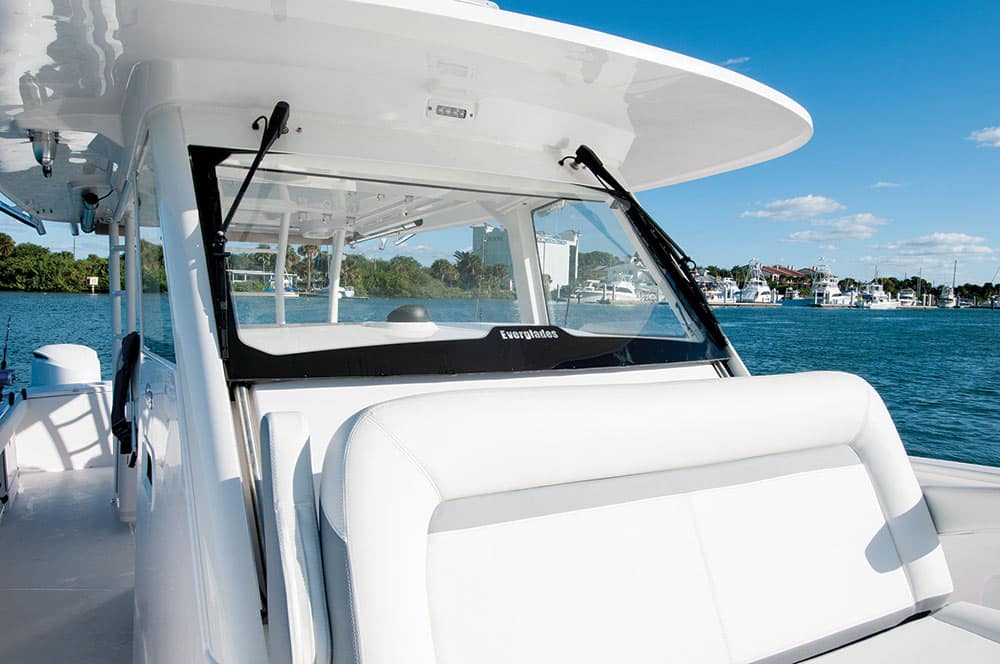
Other design details speak to further customization, though they could be considered lower-tech: trays for cellphones behind the second-row helm seating, a slide-out Yeti cooler beneath the forward module, a telescoping SureShade canopy and an electrically converting interior-console berth.
“Our customers wanted a boat that they could move up to, with big-boat features, but still have the convenience and ease of use of a center console,” Kwaterski says. “Also, customers stepping down from larger sport-fish boats and custom sport-fishers wanted the same fit and finish and technology as their large boats in a smaller center console.”
HydraSports Custom 53 Sueños
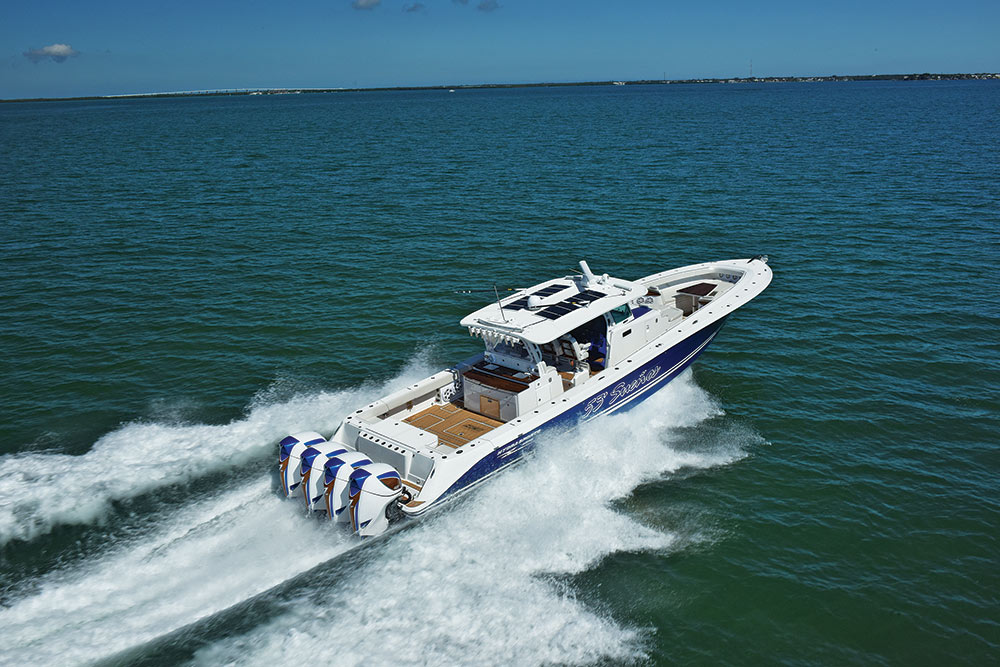
SPECS
HydraSports Custom went to naval experts to find the custom techniques necessary to build this 53-foot, outboard-powered center console. In fact, the vessel is one of the first commercial deployments of Structural Composites’ Navy SBIR advanced combatant craft technology.
The single-skin transom and hull provide the durability and ease of maintenance of solid-laminate construction but at a weight equal to or less than sandwich construction, says Terri Nuechterlein, HSC’s marketing and public relations director. In addition, the company developed a new Megaform preform stringer system, which appears to resemble a skeleton with a vertebral column. Foam stringers, ribs and bulkheads blanket the hull surface, leaving no open space measuring greater than 11 inches, including overlay.
Abovedecks, the 5300 bears every new owner’s unique desires. “The stringer grid’s small panel sizes allow us to quickly make any change we need to accommodate customer tweaks, without any tooling changes or major surgery to the hull,” Nuechterlein says.
Another unusual attribute: All boxes and lids are Frigid Rigid coolers built into the deck; all livewells are totally insulated from the top. The twin 200-gallon fish boxes flanking the aft cockpit feature 12-volt chiller plates that minimize the need for ice.
Helm and Bow Seating
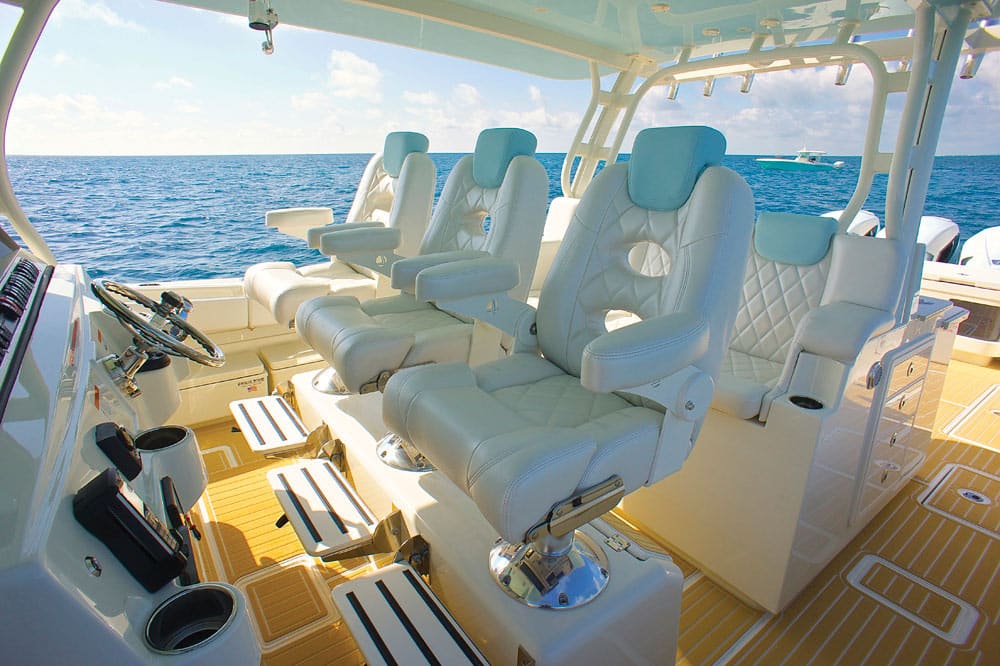
Swiveling suspension-seat pedestals at the helm create the ultimate cushioned ride. In the cockpit, dual inward-opening docking doors — one on either side of the cockpit — make it easy to land fish, carry gear aboard or disembark to snorkel, dive or wade-fish.
From the deck, between bow loungers, a platform rises electronically on twin pedestals to form a huge forward sun pad or casting deck. Raise the platform higher to create a dining space. HSC has also customized several 53s with solar power.
“Since the successful launch of the 53 Sueños, we have already unveiled a new model built in the same vein — the 39 Speciale,” Nuechterlein says. We also have two new models we’re launching in 2018, a 65-footer and a 35-footer. Both of these models will utilize Mil Tough construction.”
Pursuit S 368
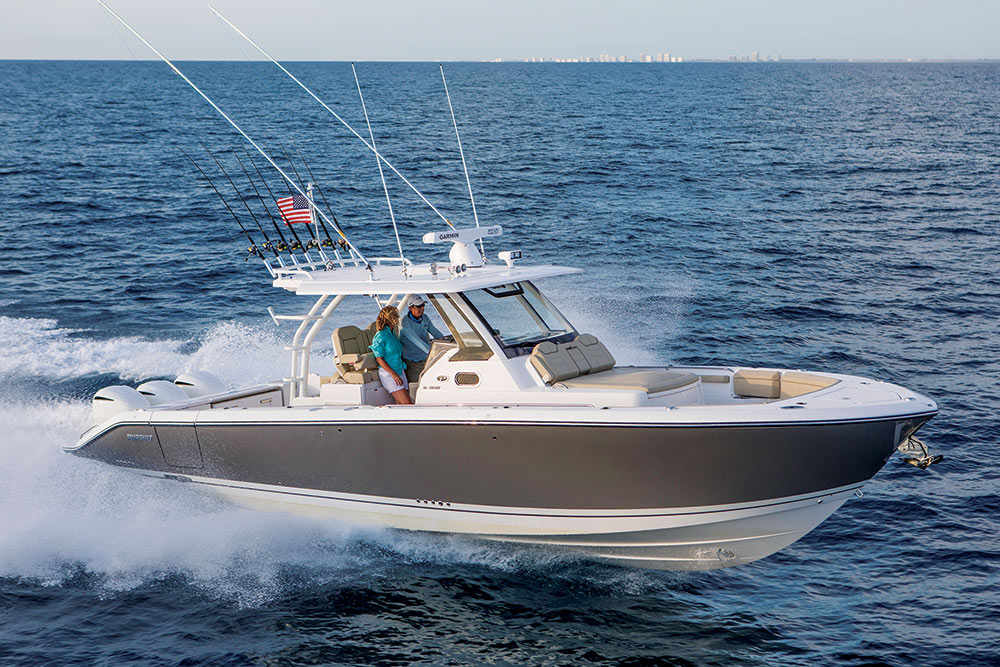
SPECS
Pursuit’s S 368 is the newest in the company’s Sport lineup and only slightly smaller than the flagship S 408. “The Sport series of luxury center consoles from Pursuit is a combination of offshore performance, fishing-friendly features and comfortable seating within all social zones on the boat,” says David Glenn, marketing manager. “At the technology level, it’s all the things you don’t see — lamination, design and build — that give customers an exceptional product.”
Pursuit uses a single one-piece, vacuum-infused stringer system that’s bonded to the hull prior to decking. Infusion delivers a reliable part with consistent high quality, Glenn says.
The S 368 also comes with a fully integrated fiberglass hardtop and windshield assembly. “The tempered-glass panels are bonded forward, port and starboard to a specific flat similar to automobile construction,” he says.
Design and Construction
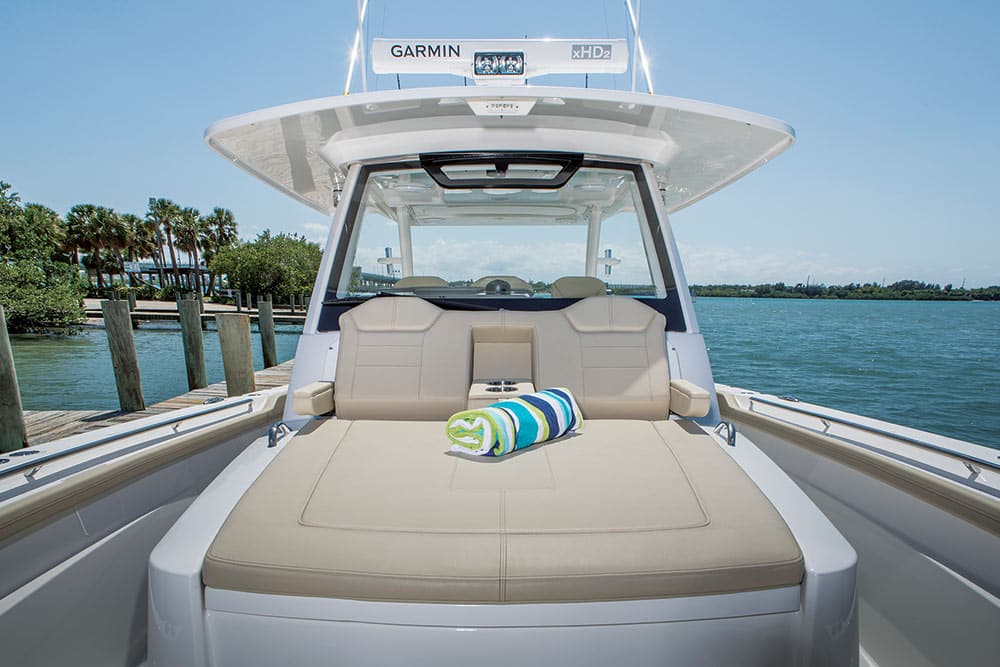
A passive drainage system for the decks funnels unwanted water toward a gutter, then overboard, without the use of hoses belowdecks. “We also use a combination of foams and coring materials within the lamination and assembly to limit both the transfer of water noise and exterior sounds in the cabin experience.”
At the helm, Pursuit installs Garmin electronics, which are paired to the Yamaha engine controls, including the Helm Master joystick system. “Captains can monitor all engine and navigation functions simultaneously and control the JL marine audio system through the touch screens,” Glenn says.
Scout 380 LXF
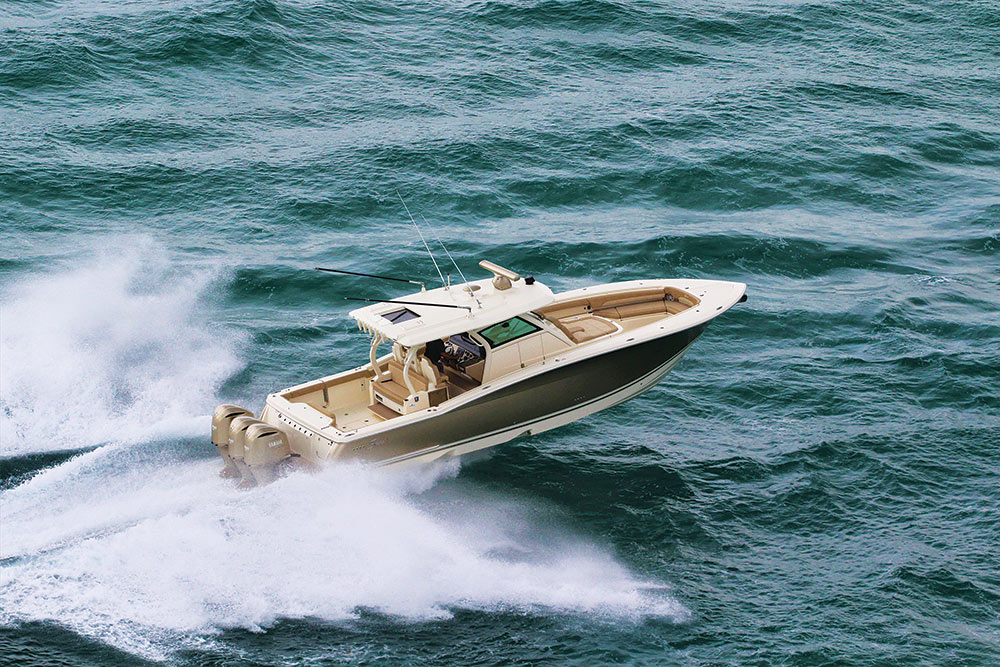
SPECS
In both its construction and its features, Scout’s 380 LXF demonstrates some of the best technology available. Hand laid and epoxy infused, the hull is chemically bonded with methacrylate, which is stronger than fiberglass and expensive to use, says director of sales and marketing Alan Lang. The 380 is also specially designed to house a Seakeeper gyrostabilizer.
The transom bracket aft is also part of the hull’s stringer system, and its structure runs all the way to the bow. “You can feel the difference in all of these high-tech build features,” Lang says.
Digital Control and Monitoring
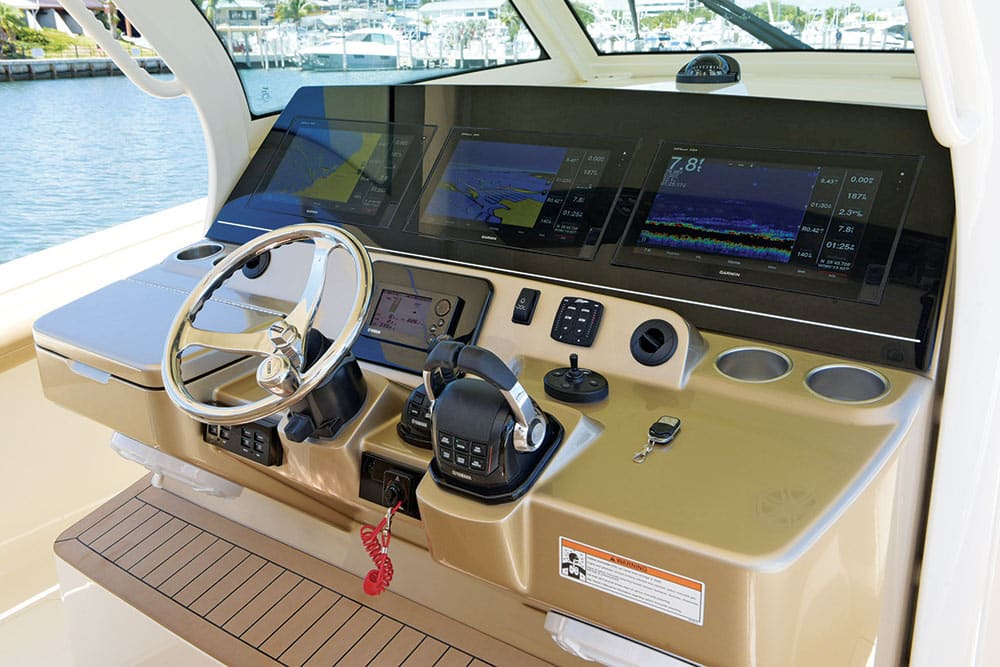
What you see abovedecks includes the integration of CZone technology, which is a digital control and monitoring network. All ship’s systems, security and electronics funnel through the helm’s multifunction display. CZone enables remote start and accommodates remote monitoring on a smartphone or tablet.
Scout also can program the CZone system to a customer’s needs. For instance, one buyer wanted a forward spreader light to turn on if the bilge pump engaged.
The 380 also comes with Scout’s patented retractable rocket-launcher system at the back edge of the standard hardtop. With the press of a button, the rocket launcher cants aft, tilting its load of fishing rods to a horizontal position before allowing the hardtop’s SureShade to deploy over the cockpit. That innovation won an award at this year’s Miami International Boat Show.
Extra Options
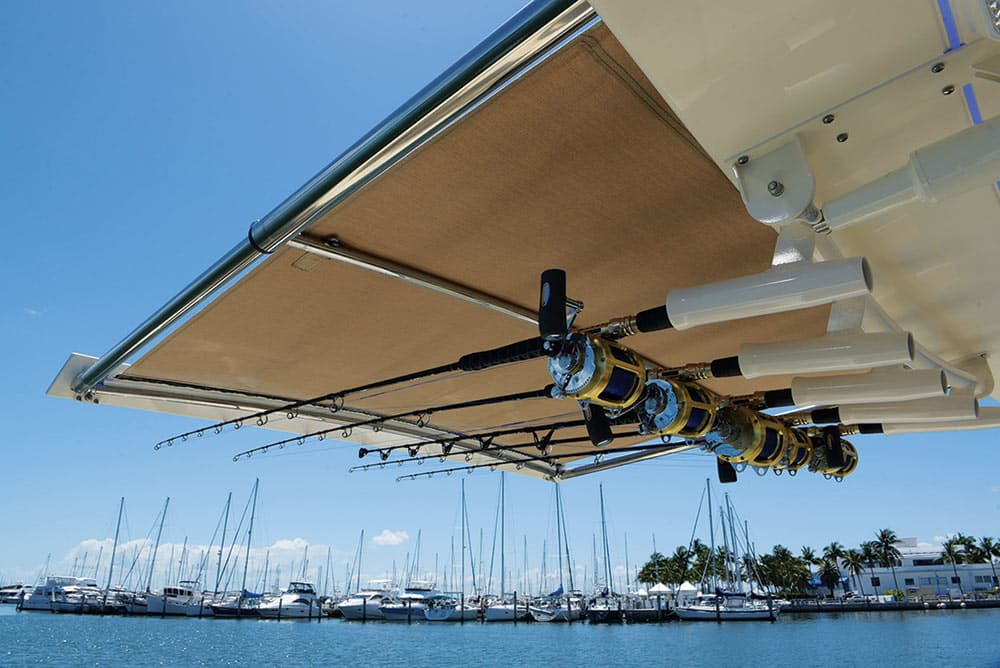
In addition, the leaning post converts electrically from an aft-facing seat to a summer kitchen with grill, sink and cutting board.
“We realize that customers want to do more than fish on a boat this size; they want to entertain, in style,” Lang says. “Our larger LXF models offer some features that are pretty complex; therefore, they aren’t cheap. They’re built to the highest level of quality. It’s important that we build them to last. Our reputation is on the line with every boat.”
SeaVee 430FA
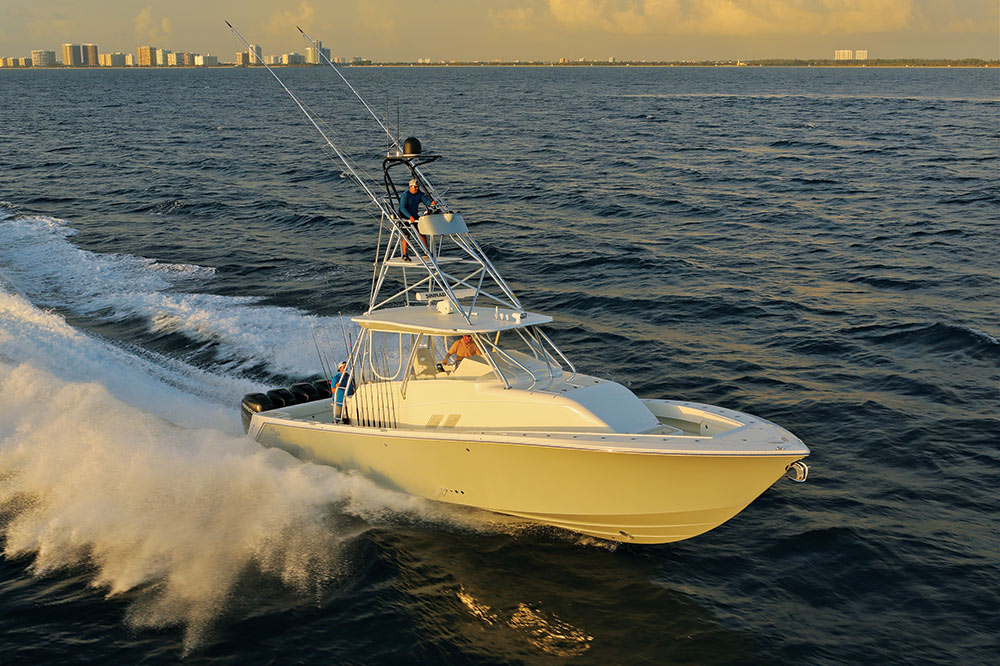
SPECS
Though the use of 3D modeling and simulation now enjoys more widespread use, at least in semicustom boatbuilding, SeaVee takes it to the highest level, with tools that allow architects to “crawl inside” the boat. That permits them to examine spaces that might have previously been inaccessible in order to open up their deck designs. The software also theoretically floats the boat for optimal waterline and trim angles.
Fishing Features
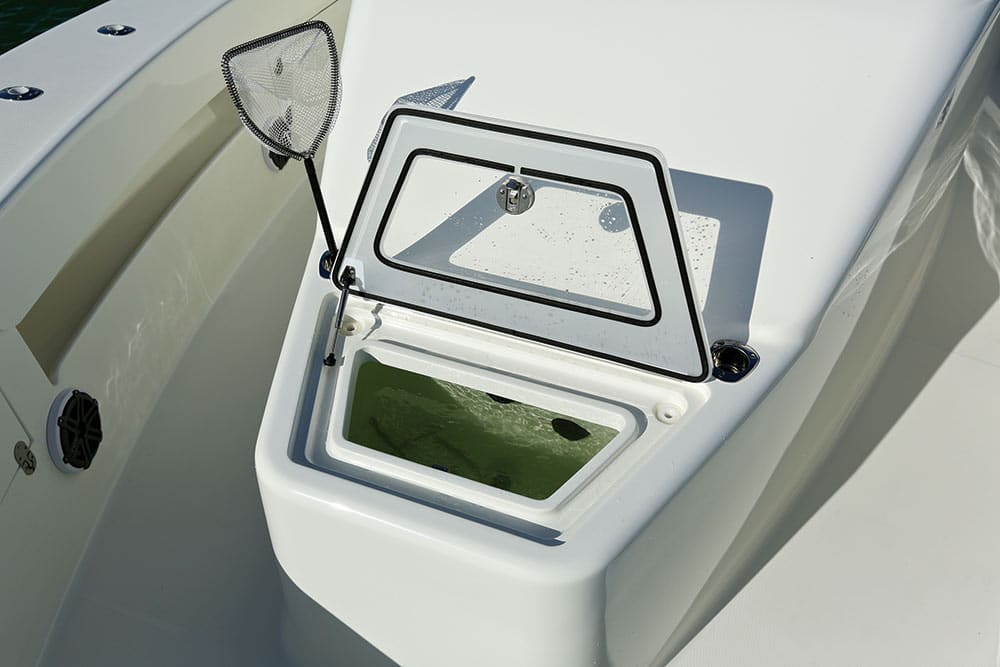
The 430FA also features a host of bells and whistles, such as an electrically operated actuator lift for the bridge deck (on the inboard version), air-actuated trim tabs that create less turbulence, specially molded twin aft livewells made from complex multipiece molds, and a side-door system with custom-made Soss hinges and a hidden in-deck retractable boarding ladder.
“After the introduction of our 430 Express, many of our customers requested the same hull but with even more fishability,” says SeaVee marketing director John Caballero. “We knew that the only way to create a design that could meet the requirements for a flush and fishable walkaround deck and a well-appointed yachtlike interior was to use some very high technology and different design methodology.”
Hull Design
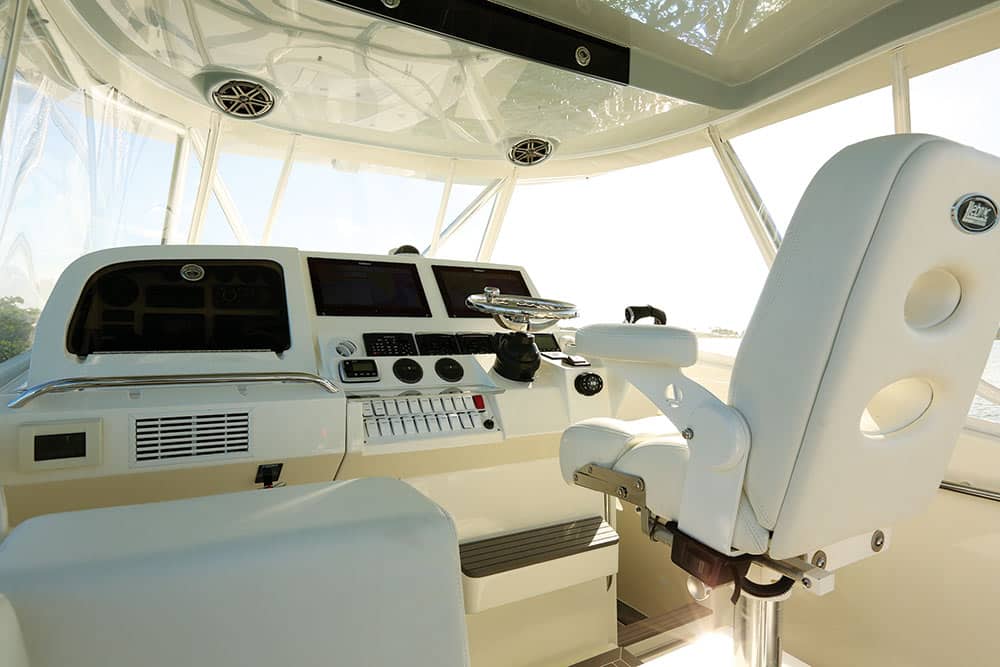
SeaVee designed the entire boat virtually before any tooling started “to capture all of the interior space so we could dedicate sufficient exterior space to the fishability.”
Since this groundbreaking process, SeaVee has employed the same techniques to innovate with its 370Z and 270Z hulls. “We look forward to continuing to use computer simulation to create ever-higher-technology designs that are more functional, easier to maintain, lighter, faster and more reliable,” Caballero says.

